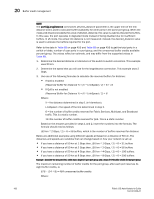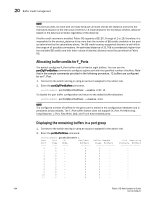HP StorageWorks 1606 Brocade Fabric OS Administrator's Guide v6.3.0 (53-100133 - Page 495
Allocating buffer credits based on average-size frames, For 8 Gbps,
 |
View all HP StorageWorks 1606 manuals
Add to My Manuals
Save this manual to your list of manuals |
Page 495 highlights
Buffer credit management 20 24 = the number of user ports in a port group retrieved from Table 88 on page 455. 8 = the number of reserved credits for each user port. 676 = the number of buffer credits available in the port group. If you allocate the entire 484 + 8 (8 for the reserved buffers already allocated to that user port) = 492 buffers to a single port, you can calculate the maximum single port extended distance supported: [Maximum Distance X in km] = (BufferCredits + 6) * 2 / LinkSpeed 498 km = (492 + 6 buffers for Fabric Services) * 2 / 2 Gbps How many 50 km ports can you configure? If you have a distance of 50 km at 8 Gbps then, 484 / (206 - 8) = 2 ports The numbers used are: 484, which equals the total number of unreserved buffer credits, 206, which equals buffer credits needed for 50 km @ 8 Gbps (calculated previously), and 8, which equals number of reserved buffer credits already allocated to that port. The floor of the resulting number is taken because fractions of a port are not allowed. If you have a distance of 50 km at 1 Gbps then, 484 / (31 - 8) = 21 ports Allocating buffer credits based on average-size frames In cases where the frame size is average, for example 1024 bytes, you must allocate twice the buffer credits or give twice the distance in the long-distance LS configuration mode. Refer to the Fibre Channel gigabit values reference definition to get an approximation of the calculated number of buffer credits. 1. Use the following formula to calculate value for the desired_distance needed for Fabric OS to determine the number of BB credits to allocate: desired_distance = roundup [(real_estimated_distance * 2112) / average_payload_size] Where average_payload_size = 1024 bytes This example uses 100 km for the real estimated distance. desired_distance = roundup [(100 * 2112) / 1024] = 207 When configuring the LS mode with the portCfgLongDistance command, enter a desired_distance value of 207 for an actual 100 km link connected to an 8 Gbps E_Port. This causes Fabric OS to allocate the correct number of BB credits. 2. Determine the speed that you will use for the long-distance connection. This example uses 8 Gbps. 3. Look up the data_rate value for the speed of the connection. See "Fibre Channel gigabit values reference definition" on page 451 to determine the data_rate value. For 8 Gbps, the data_rate is 8.5 4. Use the following formula to calculate the number of buffer-to-buffer credits to allocate: BB credits = roundup [desired_distance * (data_rate / 2.125)] Using the values for desired_distance and data_rate from step 1 and step 3, the value for BB credits is calculated as follows: BB credits = roundup [(207 * 8.5) / 2.125] = 828 Fabric OS Administrator's Guide 453 53-1001336-01















